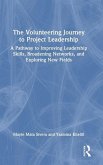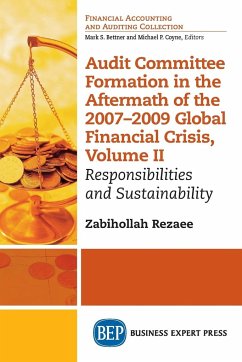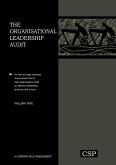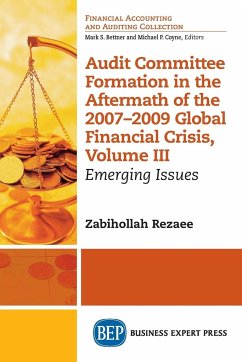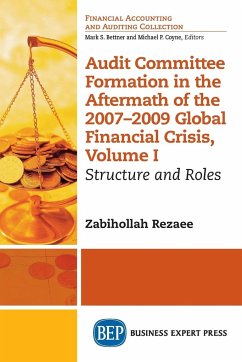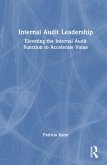Audley L. Bell
Global Audit Leadership
A Practical Approach to Leading a Global Internal Audit (GIA) Function in a Constantly Changing Internal and External Landscape
Audley L. Bell
Global Audit Leadership
A Practical Approach to Leading a Global Internal Audit (GIA) Function in a Constantly Changing Internal and External Landscape
- Gebundenes Buch
- Merkliste
- Auf die Merkliste
- Bewerten Bewerten
- Teilen
- Produkt teilen
- Produkterinnerung
- Produkterinnerung
The book provides advice and guidance to assist stakeholders navigate the challenges and demands of change. It includes insights, measures, and tools that have contributed to my success as a leader in the internal audit profession for 27 years.
Andere Kunden interessierten sich auch für
![The Volunteering Journey to Project Leadership The Volunteering Journey to Project Leadership]() Mayte Mata SiveraThe Volunteering Journey to Project Leadership167,99 €
Mayte Mata SiveraThe Volunteering Journey to Project Leadership167,99 €![Political Risk Intelligence for Business Operations in Complex Environments Political Risk Intelligence for Business Operations in Complex Environments]() Robert MckellarPolitical Risk Intelligence for Business Operations in Complex Environments199,99 €
Robert MckellarPolitical Risk Intelligence for Business Operations in Complex Environments199,99 €![Audit Committee Formation in the Aftermath of 2007-2009 Global Financial Crisis, Volume II Audit Committee Formation in the Aftermath of 2007-2009 Global Financial Crisis, Volume II]() Zabihollah RezaeeAudit Committee Formation in the Aftermath of 2007-2009 Global Financial Crisis, Volume II21,99 €
Zabihollah RezaeeAudit Committee Formation in the Aftermath of 2007-2009 Global Financial Crisis, Volume II21,99 €![The Organisational Leadership Audit The Organisational Leadership Audit]() William TateThe Organisational Leadership Audit222,99 €
William TateThe Organisational Leadership Audit222,99 €![Audit Committee Formation in the Aftermath of 2007-2009 Global Financial Crisis, Volume III Audit Committee Formation in the Aftermath of 2007-2009 Global Financial Crisis, Volume III]() Zabihollah RezaeeAudit Committee Formation in the Aftermath of 2007-2009 Global Financial Crisis, Volume III21,99 €
Zabihollah RezaeeAudit Committee Formation in the Aftermath of 2007-2009 Global Financial Crisis, Volume III21,99 €![Audit Committee Formation in the Aftermath of 2007-2009 Global Financial Crisis, Volume I Audit Committee Formation in the Aftermath of 2007-2009 Global Financial Crisis, Volume I]() Zabihollah RezaeeAudit Committee Formation in the Aftermath of 2007-2009 Global Financial Crisis, Volume I21,99 €
Zabihollah RezaeeAudit Committee Formation in the Aftermath of 2007-2009 Global Financial Crisis, Volume I21,99 €![Internal Audit Leadership Internal Audit Leadership]() Patricia KaimInternal Audit Leadership200,99 €
Patricia KaimInternal Audit Leadership200,99 €-
-
-
The book provides advice and guidance to assist stakeholders navigate the challenges and demands of change. It includes insights, measures, and tools that have contributed to my success as a leader in the internal audit profession for 27 years.
Hinweis: Dieser Artikel kann nur an eine deutsche Lieferadresse ausgeliefert werden.
Hinweis: Dieser Artikel kann nur an eine deutsche Lieferadresse ausgeliefert werden.
Produktdetails
- Produktdetails
- Verlag: CRC Press
- Seitenzahl: 316
- Erscheinungstermin: 2. August 2024
- Englisch
- Abmessung: 240mm x 161mm x 22mm
- Gewicht: 640g
- ISBN-13: 9781032075358
- ISBN-10: 103207535X
- Artikelnr.: 70147858
- Herstellerkennzeichnung
- Books on Demand GmbH
- In de Tarpen 42
- 22848 Norderstedt
- info@bod.de
- 040 53433511
- Verlag: CRC Press
- Seitenzahl: 316
- Erscheinungstermin: 2. August 2024
- Englisch
- Abmessung: 240mm x 161mm x 22mm
- Gewicht: 640g
- ISBN-13: 9781032075358
- ISBN-10: 103207535X
- Artikelnr.: 70147858
- Herstellerkennzeichnung
- Books on Demand GmbH
- In de Tarpen 42
- 22848 Norderstedt
- info@bod.de
- 040 53433511
Audley L. Bell, CPA, CIA, CISA, CFE, DHL, has a professional career that spans over 40 years, including 35 in internal audit and 4 in public accounting. Additionally, he spent four years teaching accounting at the undergraduate level at the University of the West Indies in Jamaica. During his 27-year tenure leading internal audit functions, he served as the leader of internal audit for seven organizations, including two global organizations for 13 years. He also developed five internal audit functions and two in-house investigations units within the internal audit function. Additionally, he served as a member of the ethics, compliance, and enterprise risk management leadership team at one organization, and he oversaw the development of the plan for the implementation of an ERM program at another. His work experience covers several sectors and industries, including publicly traded companies, financial institutions, quasi-governmental entities, colleges and universities, construction, manufacturing, distribution, telecommunications, transportation, non-governmental organizations, micro-finance, and a credit union. The role included working closely with senior management and audit committees and other internal and external stakeholders. Prior to realizing his passion for internal audit, his first career was on the tennis court. He won several singles tennis tournaments at the junior and adult levels in Jamaica and represented Jamaica as a junior player and in Davis Cup competitions. He was the runner-up for the 1971 men's singles National Junior College Tennis Championships (NJCTC) while he attended Wingate Junior College, now Wingate University, on a tennis scholarship. The team, coached by Ronnie Smarr, won back-to-back national tennis championships in 1970 and 1971. Unbeknownst to him, Mr. Bell was the first Black tennis player in the Atlantic Coast Conference. He continued his college tennis journey at Wake Forest University on a full tennis scholarship, where he played in the number-one singles position in his senior year. After defeating the number-one tennis player from the University of North Carolina, Wake Forest's main rival, he decided to drop out of Wake Forest in the spring of his senior year in 1973 to pursue tennis professionally. In the summer of 1973, he lost in the third round of the National Collegiate Athletic Association Tennis Championships and in the final set of the final qualifying round of the US Open Tennis Championships. He also played Ilie Nastase, the number-one tennis player in the world at the time, in the Jamaica Invitational in November 1973 and lost to him 6-2, 7-5. After assessing his options, he did not believe he had a sustainable future in tennis as he was unable to financially support himself on the tennis tour. Mr. Bell graduated cum laude with a BS in management studies and a concentration in accounting from Boston College. He is a Certified Public Accountant, a Certified Internal Auditor, a Certified Information System Auditor, and a Certified Fraud Examiner. He received an honorary Doctor of Humane Letters from Wingate University, where he is a member of the board of trustees and the chair of the audit committee. He is a former chair of Xcel's Federal Credit Union Supervisory Committee. He also served the Institute of Internal Auditors at the global and chapter levels in various roles in the past. This includes his being a member of the Board of Trustees of the Research Foundation, District Representative for the Caribbean, and Chair of the Government Relations Committee of the New York Metropolitan Chapter.
1. Transformation to an Agile Leadership and Operating Environment. 2. Role
and Responsibilities of the Chief Audit Executive. 3. Laying the Foundation
for the Success of the Chief. 4. Building and Maintaining Relationships
with Stakeholders. 5. Managing a Multicultural Global Internal Audit Team.
6. Managing Change. 7. Transformation to a Risk-Based Internal Audit
Operating Environment. 8. Automation of Internal Audit Operations. 9.
Establishment of an Enterprise Risk Management Program. 10. Internal
Controls as Stakeholders' Best Friend. 11. Getting the Most from Assurance
Functions. 12. Clean Sheet of Paper Internal Audit Approach. 13. Enhancing
the Effectiveness and Efficiency of Internal Audit. 14. Enhancing Internal
Audit's Value to the Organization. 15. Scaling Up Advisory Review Services.
16. Establishing a Proactive Fraud Investigation Function. 17. Mindset and
Skillset of the Next Generation of Leaders of Internal Audit.
and Responsibilities of the Chief Audit Executive. 3. Laying the Foundation
for the Success of the Chief. 4. Building and Maintaining Relationships
with Stakeholders. 5. Managing a Multicultural Global Internal Audit Team.
6. Managing Change. 7. Transformation to a Risk-Based Internal Audit
Operating Environment. 8. Automation of Internal Audit Operations. 9.
Establishment of an Enterprise Risk Management Program. 10. Internal
Controls as Stakeholders' Best Friend. 11. Getting the Most from Assurance
Functions. 12. Clean Sheet of Paper Internal Audit Approach. 13. Enhancing
the Effectiveness and Efficiency of Internal Audit. 14. Enhancing Internal
Audit's Value to the Organization. 15. Scaling Up Advisory Review Services.
16. Establishing a Proactive Fraud Investigation Function. 17. Mindset and
Skillset of the Next Generation of Leaders of Internal Audit.
1. Transformation to an Agile Leadership and Operating Environment. 2. Role
and Responsibilities of the Chief Audit Executive. 3. Laying the Foundation
for the Success of the Chief. 4. Building and Maintaining Relationships
with Stakeholders. 5. Managing a Multicultural Global Internal Audit Team.
6. Managing Change. 7. Transformation to a Risk-Based Internal Audit
Operating Environment. 8. Automation of Internal Audit Operations. 9.
Establishment of an Enterprise Risk Management Program. 10. Internal
Controls as Stakeholders' Best Friend. 11. Getting the Most from Assurance
Functions. 12. Clean Sheet of Paper Internal Audit Approach. 13. Enhancing
the Effectiveness and Efficiency of Internal Audit. 14. Enhancing Internal
Audit's Value to the Organization. 15. Scaling Up Advisory Review Services.
16. Establishing a Proactive Fraud Investigation Function. 17. Mindset and
Skillset of the Next Generation of Leaders of Internal Audit.
and Responsibilities of the Chief Audit Executive. 3. Laying the Foundation
for the Success of the Chief. 4. Building and Maintaining Relationships
with Stakeholders. 5. Managing a Multicultural Global Internal Audit Team.
6. Managing Change. 7. Transformation to a Risk-Based Internal Audit
Operating Environment. 8. Automation of Internal Audit Operations. 9.
Establishment of an Enterprise Risk Management Program. 10. Internal
Controls as Stakeholders' Best Friend. 11. Getting the Most from Assurance
Functions. 12. Clean Sheet of Paper Internal Audit Approach. 13. Enhancing
the Effectiveness and Efficiency of Internal Audit. 14. Enhancing Internal
Audit's Value to the Organization. 15. Scaling Up Advisory Review Services.
16. Establishing a Proactive Fraud Investigation Function. 17. Mindset and
Skillset of the Next Generation of Leaders of Internal Audit.


